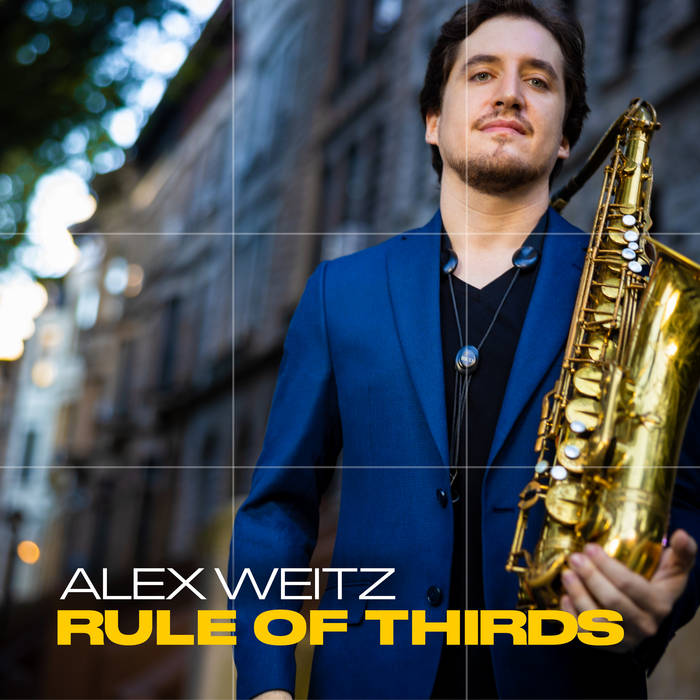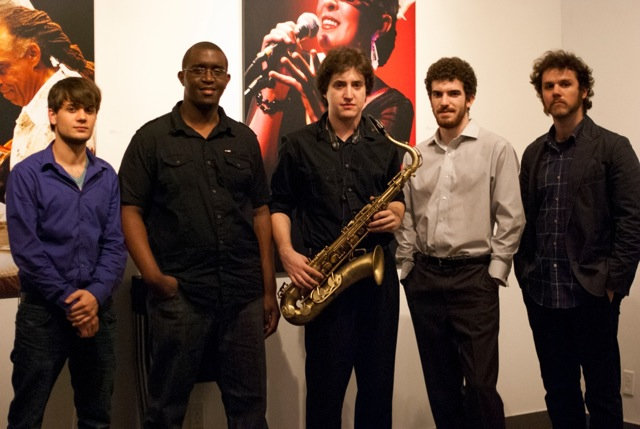
Alex Weitz, Rule of Thirds Review
Alex Weitz, Rule of Thirds Review
Musical Exploration and Growth: Alex Weitz’s Rule of Thirds
 In the world of jazz, where improvisation often meets tightly knit collaboration, Alex Weitz’s Rule of Thirds emerges as a musical ecosystem, alive and evolving, brimming with raw energy and soulful artistry. Named after a principle in photography where subjects are placed along imaginary lines to create balance and intrigue, the album presents a harmonious blend of elements akin to a well-framed nature photograph. It’s like stepping into a dense forest, where every rustle of leaves and every chirp of a bird becomes part of an organic symphony conducted by Mother Nature herself. Weitz and his ensemble become the musical flora and fauna, interacting, growing, and weaving a tapestry that is both refreshing and nostalgic.
In the world of jazz, where improvisation often meets tightly knit collaboration, Alex Weitz’s Rule of Thirds emerges as a musical ecosystem, alive and evolving, brimming with raw energy and soulful artistry. Named after a principle in photography where subjects are placed along imaginary lines to create balance and intrigue, the album presents a harmonious blend of elements akin to a well-framed nature photograph. It’s like stepping into a dense forest, where every rustle of leaves and every chirp of a bird becomes part of an organic symphony conducted by Mother Nature herself. Weitz and his ensemble become the musical flora and fauna, interacting, growing, and weaving a tapestry that is both refreshing and nostalgic.
Ensemble Harmony
Alex Weitz takes the lead as the saxophonist and composer for this ensemble, showcasing an array of talent that helps bring his vision to life. The pianist’s role is shared between Emmet Cohen, who plays the keys on tracks 1, 6, and 9, and Tal Cohen, whose touch can be heard on tracks 2, 3, 4, 5, 7, and 8. Yotam Silberstein’s guitar work adds color to tracks 2 and 5, while Marcus Printup’s trumpet lends an exciting dynamic to track 6. The rhythm section, an essential backbone to the ensemble, consists of Ben Tiberio on bass, while the drums are handled by Ari Hoenig on tracks 1 and 8, and Michael Piolet across tracks 2, 3, 4, 5, 6, and 7. Together, these musicians create a rich tapestry of sound that’s bound to intrigue and inspire listeners.
Tracks of Intrigue
“The Hive”
Starting with “The Hive,” we are welcomed into Weitz’s woodland with a flurry of saxophone notes, like birds taking flight. Tal Cohen’s piano dances like sunlight filtering through the leaves, while Ari Hoenig’s drumming resonates with the heartbeat of the earth. The intricate interplay of musicians, anchored by Tiberio’s consistent bass foundation, is a walk through an enchanted forest, where every twist and turn reveals new surprises. Weitz’s soloing vocabulary is of today’s modern jazz sounds, and his youthful energy jumps from the speakers.
“Rude Awakening”
“Rude Awakening” aptly captures the disruptive elements in nature, akin to a photograph where a sudden thunderstorm brews in the distance while an awakening predator looms in the foreground. In this piece, Weitz’s energy during his solo occasionally loses its way. He leans heavily on technique, inserting more ideas than building consistent patterns and themes. This over-reliance on technical ability results in a flat listening experience, one that resonates with the sound of technical execution but lacks emotional impact. Piolet’s drumming, however, remains on point throughout the composition, anchoring the energy and controlling the raw power of the ensemble as it explores its sonic realm. The composition’s textured melody is fascinating, reflecting nature’s way of creating chaotic yet beautiful patterns, mirrored in the changes of feel and texture within the piece.
thunderstorm brews in the distance while an awakening predator looms in the foreground. In this piece, Weitz’s energy during his solo occasionally loses its way. He leans heavily on technique, inserting more ideas than building consistent patterns and themes. This over-reliance on technical ability results in a flat listening experience, one that resonates with the sound of technical execution but lacks emotional impact. Piolet’s drumming, however, remains on point throughout the composition, anchoring the energy and controlling the raw power of the ensemble as it explores its sonic realm. The composition’s textured melody is fascinating, reflecting nature’s way of creating chaotic yet beautiful patterns, mirrored in the changes of feel and texture within the piece.
“Harlem Lullaby”
“Harlem Lullaby” unfolds with the grace and balance of a composition adhering to the Rule of Thirds in photography—a much-needed relaxed exploration, reminiscent of a moonlit stroll. Like a well-framed photograph, where elements are carefully aligned along intersecting lines, the flowing melodies from Weitz’s saxophone linger in the shadows, building slowly to a crescendo as intense and unpredictable as the night itself. Tiberio’s bass, following a wonderful solo, forms a structural branch supporting Weitz’s gentle rustling leaves, all framed with meticulous care, akin to a photographic composition. Tal Cohen’s piano paints the shimmering glow of stars during his improvisational exploration, each note strategically placed like elements in a balanced image, further enriching the atmospheric imagery of the piece.
“Odyssey”
“Odyssey” is the highlight of the album. An outstanding modern jazz composition supports the ensemble as they collaborate to make this a memorable experience. Silberstein’s guitar playing is a big part of this, as is the rhythmic agility of Tiberio and Piolet’s well-grounded rhythmic unit. Weitz performs his most arching and consistent solo of the date, his ideas are clear and show promise of bright things to come. Silberstein’s solo is modern and uses blues colors to add that extra feeling.
Synergy and Unfulfilled Potential
 Rule of Thirds thrives on collaboration and interaction through all the various layers. Whether it’s the soft embrace of “Nocturne in C Sharp Minor” that builds to a crescendo of intensity or the bold declaration of an imaginative arrangement of the standard “Love For Sale,” Weitz’s leadership gives the ensemble members room to grow, each member growing like the branches of a tree, branching out into unexpected directions, but having a common grounded center. “Convent Court” is a solid swing track that has the elegant sounds of Printup’s trumpet. I would have loved to hear more moments like this on the album when the ensemble clicks, and you get that feel of rhythmic delight and melodic clarity that elevates your spirits; I know it did mine.
Rule of Thirds thrives on collaboration and interaction through all the various layers. Whether it’s the soft embrace of “Nocturne in C Sharp Minor” that builds to a crescendo of intensity or the bold declaration of an imaginative arrangement of the standard “Love For Sale,” Weitz’s leadership gives the ensemble members room to grow, each member growing like the branches of a tree, branching out into unexpected directions, but having a common grounded center. “Convent Court” is a solid swing track that has the elegant sounds of Printup’s trumpet. I would have loved to hear more moments like this on the album when the ensemble clicks, and you get that feel of rhythmic delight and melodic clarity that elevates your spirits; I know it did mine.
Conclusion: A Journey into the Wild
In Rule of Thirds, we find an album that is reaching into the very essence of life itself. It’s a musical garden cultivated with care, nourished by creativity, and explored with authenticity. Yet, much like nature, Rule of Thirds is not without its imperfections, as it is a journey into the wild, uncharted territories of music, where every note is a living, breathing entity. Listen, explore, and allow yourself to be lost and found in the rich, musical wilderness of Weitz’s musical mind. It’s an expedition well worth embarking on, a celebration of jazz that promises to grow within you as you continue to explore its bounty and flowing moments.
Alex Weitz
Rule of Thirds
Alex Weitz - saxophone, composer
Emmet Cohen - piano (1,6,9)
Tal Cohen - piano (2,3,4,5,7,8)
Yotam Silberstein - guitar (2,5)
Marcus Printup - trumpet (6)
Ben Tiberio - bass
Ari Hoenig - drums (1,8)
Michael Piolet - drums (2,3,4,5,6,7)
Recorded at Big Orange Sheep in Brooklyn, NY
Engineered, Mixed, and Mastered by Michael Perez-Cisneros
Outside in Music
April 28, 2023